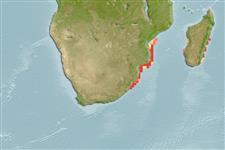Common names from other countries
Elasmobranchii (Haie und Rochen) (sharks and rays) >
Carcharhiniformes (Ground sharks) >
Pentanchidae (Deepwater catsharks)
Etymology: Halaelurus: halos (Gr.), sea; ailouros (Gr.), cat, probably an allusion to the vernacular “catshark,” so named for its cat-like eyes. (See ETYFish); lineatus: Latin for lined, referring to its 13 pairs of narrow dark-brown stripes. (See ETYFish).
Environment: milieu / climate zone / depth range / distribution range
Ökologie
seewasser demersal; tiefenbereich 0 - 290 m (Ref. 5510). Subtropical; 19°S - 31°S
Western Indian Ocean: Beira, Mozambique to East London, South Africa.
Size / Gewicht / Alter
Maturity: Lm ? range ? - ? cm
Max length : 56.0 cm TL Männchen/unbestimmt; (Ref. 244); 52.0 cm TL (female)
Kurzbeschreibung
Morphologie | Morphometrie
Rückenflossenstacheln (insgesamt): 0; Rückenflossenweichstrahlen (insgesamt): 0; Afterflossenstacheln 0; Afterflossenweichstrahlen: 0. A catshark with an upturned knob on the snout, a narrow head, and numerous small dark spots on the body (Ref. 5578). Pale brown with numerous pairs of narrow, vertical, dark brown stripes outlining obscure dusky saddles (Ref. 5578), cream below (Ref. 5510).
Found on the continental shelf and uppermost slope, on soft bottoms, from close inshore to 290 m (Ref. 5578). Feeds on small crustaceans, bony fish, and cephalopods (Ref. 5578). Although commonly caught by shore anglers, it is not generally considered a game fish (Ref. 12484).
Life cycle and mating behavior
Geschlechtsreife | Fortpflanzung | Ablaichen | Eier | Fecundity | Larven
Probably lays eggs, with up to 16 egg-cases per female; eggs retained until embryos reach advanced stage of development (Ref. 5578).
Compagno, L.J.V., 1984. FAO Species Catalogue. Vol. 4. Sharks of the world. An annotated and illustrated catalogue of shark species known to date. Part 2 - Carcharhiniformes. FAO Fish. Synop. 125(4/2):251-655. Rome: FAO. (Ref. 244)
IUCN Rote Liste Status (Ref. 130435)
CITES (Ref. 128078)
Not Evaluated
Bedrohung für Menschen
Harmless
Nutzung durch Menschen
Fischereien: nicht kommerziell; Sportfisch: ja; Aquarium: Öffentliche Aquarien
Mehr Information
ReferenzenAquakulturAquakultur ProfilZuchtlinienGenetikElectrophoresesVererbbarkeitKrankheitenVerarbeitungMass conversion
PartnerBilderStamps, Coins Misc.LauteCiguateraGeschwindigkeitSchwimmstilKiemenoberflächeOtolithsGehirngrößeSehfähigkeit
Tools
Zusatzinformationen
Download XML
Internet Quellen
Estimates based on models
Preferred temperature (Ref.
115969): 18.6 - 25.3, mean 22.7 (based on 22 cells).
Phylogenetic diversity index (Ref.
82804): PD
50 = 0.5078 [Uniqueness, from 0.5 = low to 2.0 = high].
Bayesian length-weight: a=0.00269 (0.00144 - 0.00502), b=3.05 (2.88 - 3.22), in cm Total Length, based on LWR estimates for this species & (Sub)family-body (Ref.
93245).
Trophic level (Ref.
69278): 4.5 ±0.60 se; based on food items.
Widerstandsfähigkeit (Ref.
120179): niedrig, Verdopplung der Population dauert 4,5 - 14 Jahre. (Fec assumed to be <100).
Fishing Vulnerability (Ref.
59153): Moderate vulnerability (42 of 100).
